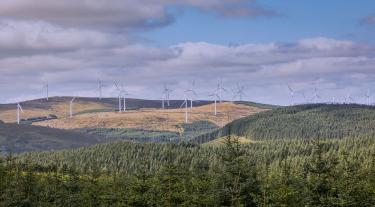Net Zero, explained by our experts.

Net Zero123 is the most comprehensive approach there is to securing a liveable planet.
Achieving Net Zero involves making deep reductions in greenhouse gas emissions to get as close to zero as possible, and then actively removing from the atmosphere any emissions that really cannot be avoided.
Once we achieve this balance of emissions and removals, global warming stops worsening. Emissions from human activities have already warmed the planet by around 1.2C (above levels experienced before industrialisation) and there is a scientific consensus that staying below 1.5C will avoid the most catastrophic effects on our climate.
The 2015 Paris Agreement set out an international commitment to pursue efforts to limit warming to 1.5C. Achieving that, rather than allowing temperatures to rise by 2C, would save around 61 million people from drought, bring down the financial costs of global climate damages by 25%, and prevent triggering critical climate ‘tipping points’, such as the collapse of the Greenland Ice Cap.
Climate scientists have modelled the scenarios needed to call time on global warming and prevent us from surpassing 1.5C. The pathways which shield us from the worst impacts of climate change and allow us to meet our global goal of 1.5C have a common thread: halving our emissions this decade and reaching Net Zero by around 2050. Immediate action to reduce emissions is therefore critical.
Why do we need to limit global warming to 1.5C?
A global temperature rise of a couple of degrees may not seem significant, but the consequences are serious. A temperature rise of 2C would lead to 37% of the global population being exposed to severe heat at least once every five years and climate ‘tipping points’ being reached. The Intergovernmental Panel on Climate Change, or IPCC, also predicts that 2C of warming would lead to long-lasting or irreversible impacts, including the loss of some eco-systems.
Limiting global warming to 1.5C would dramatically improve outcomes. The percentage of the population exposed to severe heat at least once every five summers would drop to around 14% and hundreds of millions fewer people would be at risk of climate change-related poverty.4
Achieving Net Zero
What progress has been made?
Almost 80% of global emissions are now covered by Net Zero targets5, and big emitters like China, the USA and the EU have set Net Zero-related targets. However, the plans in place to reach these targets do not go far enough. Even if all of the current national emissions reduction pledges are met, it is likely Net Zero by the middle of the century will be missed, and warming will exceed 1.5C.6 It is therefore vital for governments to go further and revise the ambition of their national commitments, with transition plans and policies which get us to Net Zero by 2050.
Current national pledges are not enough to reach Net Zero on time
Source: Climate Change 2022, Mitigation of Climate Change, Working Group III Contribution to the Sixth Assessment Report of the Intergovernmental Panel on Climate Change AR6 Climate Change 2022: Mitigation of Climate Change — IPCC
Net Zero is still possible. Many of the tools and techniques needed are already available, and the rewards of adopting them are significant for society and businesses. Renewable energy technologies like wind and solar are not only the cleanest, they are also now the cheapest in many locations. Net Zero policies, when designed properly, also bring health and social benefits. Acting now will also address growing expectations from consumers and investors that the companies they buy from and invest in are taking this seriously. Immediate action makes both business and climate sense.
It will mean changing how we do business, how we live and how we use technology, but businesses and communities are constantly evolving to adapt to new pressures and opportunities, and Net Zero presents a growth opportunity for those who adapt early and lead the transition. By focusing efforts on the sectors responsible for most greenhouse gas emissions and putting in place the enabling conditions for progress, we can reach Net Zero and create a better future for everyone.
FAQ
Why is 2050 the target date?
The IPCC found that in order to meet the goal of 1.5C, global emissions need to be halved by 2030 and limited to Net Zero by around 2050.7 If Net Zero is reached later than this, it is likely the planet will warm beyond 1.5C. This means that the middle of the century is an essential focus point for all global efforts to reduce emissions.
However, at the heart of the UN process for addressing climate change is a recognition that there will be some variation on specific Net Zero target dates for different countries and businesses. This reflects the complexity of responsibility for emissions reductions and the links to wider international development priorities. Some countries and businesses will set earlier targets, while others will aim for Net Zero beyond 2050. For instance, the UK has a target date of 2050 for Net Zero, while China is aiming for 2060. Many businesses are aiming to achieve Net Zero earlier than 2050.
Why do we need to act now?
The global target date for Net Zero is several decades away, but there are crucial milestones that need to be reached between now and then. The IPCC has clearly stated that to reach Net Zero by the middle of the century, we must halve global emissions by 2030. With less than a decade to go, this target will be challenging to achieve, but not impossible. Immediate and ambitious emissions reductions need to be made across supply chains and society to ensure emissions are halved by 2030 – only this urgent approach will preserve the plan to reach Net Zero by the middle of the century.
Taking immediate action also makes sense from a financial point of view. Studies have consistently shown that taking earlier action leads to reduced costs for implementing Net Zero solutions.8 In October 2022, the International Monetary Fund (IMF) outlined that the short-term costs of investing in Net Zero solutions pale in comparison to the long-term rewards of achieving Net Zero. The longer we wait to take action, the higher the up-front costs will be.9
Isn’t Net Zero a problem for governments? Why should businesses and financial institutions play a role?
Every emissions-producing activity will need to change to ensure global Net Zero emissions is reached. National and sub-national governments have an important role to play to provide the right policies, incentives and regulations to ensure this happens, but all businesses, financial institutions and individuals bear responsibility too. The choices businesses make, and the investment decisions of financial institutions are critical to determining whether or not we reach Net Zero.
Every year, world leaders meet at the UN Conference of the Parties (COP) to discuss international commitments on climate change. However, the agreements reached at COP will only have meaning if businesses, financial institutions and individuals all recognise their own role in creating the emissions that the international community seeks to reduce and then take steps to reduce the emissions they are responsible for.
Aside from being responsible for greenhouse gas emissions, businesses and financial institutions are also exposed to climate change risk. Extreme weather events threaten global economic security, which could rock supply chains and markets, or damage a business’s assets, bringing detrimental effects to both the business and its investors. It is therefore in the interest of businesses and financial institutions to drive progress towards Net Zero.
Is Net Zero the same as carbon neutrality?
Usually, Net Zero is more ambitious than carbon neutrality. However, the terms are used differently around the world. In China, for instance, the term ‘carbon neutrality’ implies the same level of ambition as Net Zero.
However, in most cases, Net Zero and carbon neutrality mean something quite different. There are three key divergences between Net Zero and carbon neutrality:
- Level of ambition: PAS 2060, the international standard for carbon neutrality, requires organisations to commit to ongoing reductions in emissions as part of a carbon neutral commitment. However, it does not specify how much organisations need to reduce by, so any trajectory can be followed. By contrast, Net Zero requires organisations to reduce emissions at a rate that is consistent with 1.5 degrees of warming.
- Scope: Carbon neutrality has a minimum requirement of covering Scope 1 & 2 emissions with Scope 3 encouraged. For businesses, Net Zero must cover all Scope 1, 2 & 3 emissions.
- Remaining emissions: to achieve carbon neutrality, organisations must purchase carbon offsets that either result in carbon reductions, efficiencies or sinks. To achieve Net Zero, organisations must instead focus on deep cuts to emissions and then any remaining emissions can be neutralised through the purchase of carbon removals that result in carbon sequestration from the atmosphere.
Net Zero is a transformational, long-term commitment. Carbon neutrality can be an important stepping stone on the journey to Net Zero.
1‘A Degree of Concern: Why Global Temperatures Matter’ (NASA Global Climate Change, 2019)
2‘Net Zero: Why 1.5C’ (Energy & Climate Intelligence Unit, 2021)
3 ‘Climate Change 2022: Mitigation of Climate Change. Working Group III Contribution to the IPCC Sixth Assessment Report’ (IPCC, 2022)
4 ‘1.5 or 2C Celsius of additional global warming: Does it make a difference?’ (Yale Climate Connections, 2021)
5 Net Zero Coalition (UN)
6 Net Zero Coalition (UN)
7 ‘Global Warming of 1.5C’ (IPCC, 2018)
8 ‘The net-zero transition: Its cost and benefits’ (McKinsey & Company, 2022)
9 ‘World Economic Outlook’ (International Monetary Fund, 2022)
Discover more about the Carbon Trust Net Zero Intelligence Unit


